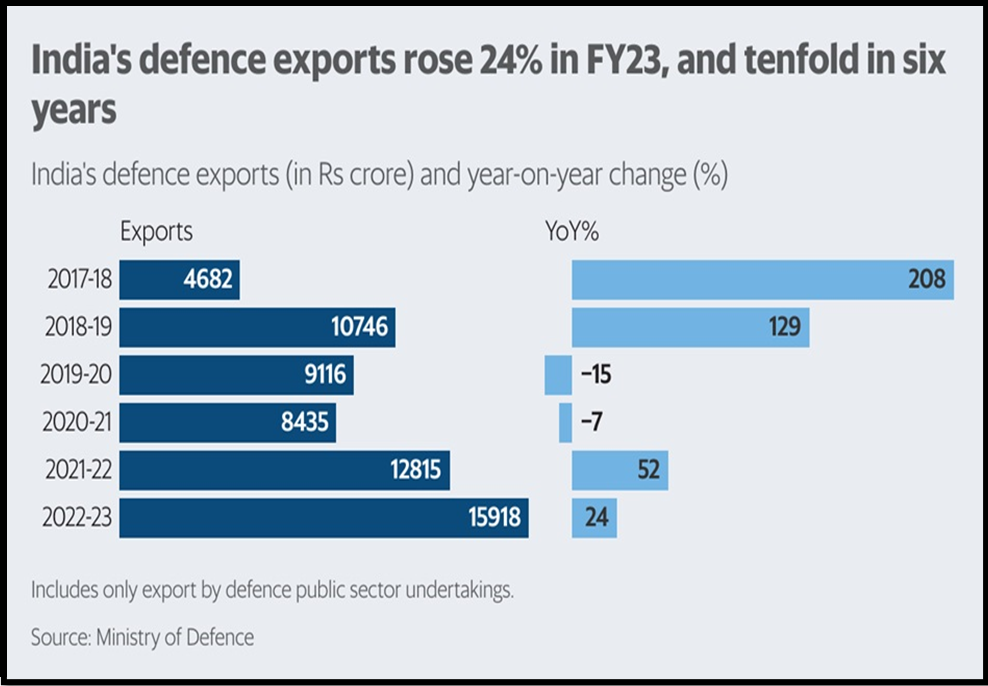INDIA’S DEFENCE EXPORT ECOSYSTEM
Syllabus:
GS 3:
- Achievements of Indians in science & technology; indigenization of technology and developing new technology.
Focus:
- India’s defence production has achieved a significant milestone, surpassing ₹1 trillion rupees ($12 billion).
- India’s defence exports have seen a significant surge in recent years, reflecting strategic reforms and policy initiatives aimed at bolstering domestic manufacturing capabilities and enhancing global competitiveness.
Historical Trends:
- In 2017-18, defence exports amounted to 24,682 crore, marking the beginning of a positive trajectory.
- Subsequently, there was a remarkable jump to 210,745 crore in 2018-19, showcasing a strong growth trend.
- Pandemic-induced challenges led to decreases in 2019-20 (29,115 crore) and 2020-21 (48,434 crore).
- However, the post-pandemic phase witnessed a robust recovery, with exports reaching 215,920 crore in 2022-23 and further increasing to 21,083 crore in 2023-24, representing a 32.43% growth.
Factors Driving Growth:
- Policy Reforms:
-
- Emphasis on reducing dependence on foreign equipment and promoting indigenous manufacturing capabilities.
- Introduction of positive indigenisation lists comprising 4,666 items sourced domestically, leading to increased localization.
- Allocation of 75% of the acquisition budget for sourcing from Indian companies, encouraging domestic production.
- Innovations for Defence Excellence (iDEX):
- iDEX initiative aimed at fostering innovation through collaboration with academia, research institutions, startups, and industry players.
- Focus on developing cutting-edge technologies domestically to meet the evolving needs of the armed forces and the global market.
- Defence Diplomacy:
- Proactive engagement in defence diplomacy to promote Indian defence products and technologies in the international market.
- Marketing efforts targeting potential overseas buyers, supported by lines of credit, Exim Bank financing, and defence offset policies.
- Integration of Ministry of External Affairs (MEA) and Indian embassies to facilitate defence exports, enhancing the outreach and visibility of Indian defence products.
Private Sector Dominance:
- The private sector accounts for 60% of defence exports, showcasing its growing role and competitiveness in the global market.
- Defence Public Sector Undertakings (DPSUs) contribute 40%, highlighting their continued significance despite increased private sector participation.
Challenges:
- Bureaucratic Inertia:
-
- Challenges in streamlining bureaucratic processes and fostering greater collaboration between the public and private sectors.
- Need for reforms to create a more conducive environment for private sector participation in defence manufacturing and exports.
- Budgetary Constraints:
- Limited allocation for defence research and development (R&D), hindering the development of innovative and competitive products.
- Greater investment in R&D necessary to enhance the technological prowess of the Indian defence industry and meet global standards.
Future Directions:
- Continued focus on defence reforms to address bureaucratic hurdles and create a more business-friendly environment for defence manufacturing.
- Enhanced investment in defence R&D to spur innovation and develop advanced technologies that meet the evolving needs of the armed forces and the global market.
- Strengthening partnerships between the public and private sectors to leverage synergies and maximize the potential of the Indian defence industry.
Conclusion:
India’s defence exports have experienced significant growth in recent years, driven by strategic reforms, policy initiatives, and proactive diplomacy. However, addressing challenges such as bureaucratic inertia and budgetary constraints is crucial for sustaining this momentum and positioning India as a leading player in the global defence market. By fostering greater collaboration between the public and private sectors and investing in innovation, India can capitalize on its strengths and realize its potential as a major exporter of defence products and technologies.
What are the Related Steps taken?
|
Mains Practice Question:
Discuss the recent surge in India’s defence exports, highlighting the key factors driving this growth and the challenges faced by the defence industry. Evaluate the role of policy reforms, initiatives like Innovations for Defence Excellence (iDEX), and defence diplomacy in promoting defence exports. Analyze the dominance of the private sector in defence exports and the significance of greater collaboration between public and private entities.
Associated Article
https://universalinstitutions.com/india-as-global-player-in-defence-sector/




